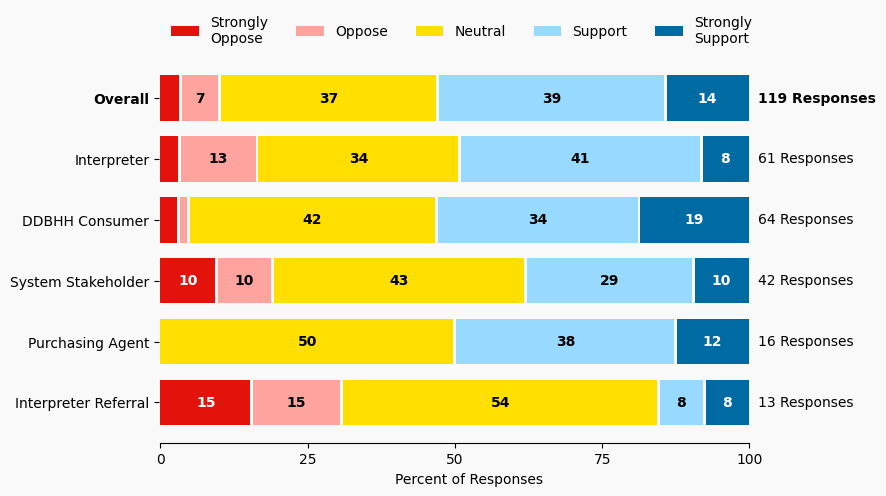31 Interpreter Referral Companies Establish and Maintain Self-Reporting to the Public
Issue: As private businesses that serve a business and social demand for communication services, information about services is generally not shared. There is a lack of knowledge about the scope of services, issue areas and fill rates.
Proposed Solution: Interpreter referral companies publish data about their services for transparency and to help guide system stakeholders and interested community members. Collected information to indicate current market, challenges and service gaps.
Expected outcome: System stakeholders and interested community members would have a better understanding of the challenge areas for interpreter referral companies. They could then invest resources with better direction to increase the quality and availability of interpreting services.
Who is impacted: Interpreter referral companies, system stakeholders
Timeline: 6 months

Summary of Support Image Description
The stacked bar charts show how respondents rated their level of support and the total number of responses. The percentage for the five support levels is shown from left to right: Strongly Oppose (Dark Red), Oppose (Light Red), Neutral (Yellow), Support (Light Blue), and Strongly Support (Dark Blue).
Respondents may identify with multiple subgroups. The overall level of support is:
Overall
Strongly Oppose: 3%
Oppose: 7%
Neutral: 37%
Support: 39%
Strongly Support: 14%
Click to see the detailed image description for each subgroup.
Interpreter
Strongly Oppose: 3%
Oppose: 13%
Neutral: 34%
Support: 41%
Strongly Support: 8%
Interpreter Referral
Strongly Oppose: 15%
Oppose: 15%
Neutral: 54%
Support: 8%
Strongly Support: 8%
DDBHH Consumer
Strongly Oppose: 3%
Oppose: 2%
Neutral: 42%
Support: 34%
Strongly Support: 19%
Purchasing Agent
Strongly Oppose: 0%
Oppose: 0%
Neutral: 50%
Support: 38%
Strongly Support: 12%
System Stakeholder
Strongly Oppose: 10%
Oppose: 10%
Neutral: 43%
Support: 28%
Strongly Support: 10%
Overview of Respondents Opting for In-Depth Solution Analysis
After indicating their support level, 0% of the 119 respondents opted in to further assess whether the solution would worsen or improve on five metrics. Of the opt-in reviewers (1 respondents), 100% supported the solution, 0% were neutral on the solution, and 0% opposed the solution.
The remaining 118 respondents did not opt in to further assess the solution. Of these people, 52% support the solution, 37% were neutral on the solution, and 10% opposed the solution.
Reviewer Evaluation of Solution Effectiveness

Solution Effectiveness Image Description
The stacked bar charts show how respondents assessed the effectiveness of this solution based on five metrics. For each metric, the percentage of respondents is shown from left to right: Worsens (Red), Improves (Blue), No Impact (Gray).
DDBHH Quality of Life
Makes It Worse 0%
Makes It Better 100%
No Impact 0%
Interpreter Satisfaction
Makes It Worse 0%
Makes It Better 100%
No Impact 0%
Consumer Choice
Makes It Worse 0%
Makes It Better 100%
No Impact 0%
Interpreting Availability
Makes It Worse 0%
Makes It Better 100%
No Impact 0%
Interpreting Quality
Makes It Worse 0%
Makes It Better 75%
No Impact 25%
Reviewer Feedback and Insights
Interpreter
Comments from Interpreters suggest that referral companies should establish clear and transparent hiring practices to ensure fairness and inclusivity. Concerns include ensuring that interpreters are hired based on their qualifications rather than other factors. Suggestions include creating a standardized hiring process that promotes transparency and accountability.
Deaf, DeafBlind, Hard of Hearing
Comments from DDBHH Consumers express support for transparent hiring practices, with concerns about ensuring that interpreters are hired based on their qualifications. Suggestions include creating a clear process for addressing complaints about hiring practices. Concerns focus on ensuring that the hiring process promotes fairness and inclusivity.
System Stakeholder
Comments from System stakeholders suggest that transparent hiring practices could help improve accountability within the interpreting profession. Suggestions include creating a standardized hiring process that ensures fairness for all interpreters. Concerns include ensuring that the hiring process promotes inclusivity and does not create unnecessary barriers for interpreters.
PREVIOUS SOLUTION
Issue: Greater Minnesota struggles to fill all interpreter requests.
NEXT SOLUTION
32 Provide Co-Navigating and Other Workshops to Interpreters
Issue: DeafBlind individuals express concerns about specific skill sets that very few interpreters are able to demonstrate.
Leave a Reply